Mid-Season Powder Sled Report
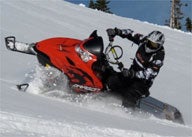
Check out how our five mountain test sleds are doing so far
Since the Christmas Holiday, Snowmobile.com’s Mountain Team of Matt, Kevin and Jake Allred has steadily rolled miles onto the Team’s five mountain snowmobiles: Yamaha’s FX Nytro MTX SE, Polaris’ 800 RMK Dragon and 700 RMK, and Arctic Cat’s M1000 Sno Pro and M8 Sno Pro. We have learned much about each and most of what we have learned is good; to that end, some learning has been just that, learning.
With the minimal and weird snow the mountains in Southeast Idaho and Western Wyoming has received, the biggest “OK-we-need-to-figure-this-out” question plaguing our minds is: what is in a track? We need to first, complete our powder sled evaluation, then finish the season, but track the differing track compounds, length and configurations that has surfaced as a key topic around our campfire. In the meantime, let’s see how our five long-term mountain sleds have fared at our mid-term report. As a result of his many hours logged, Test Rider Kevin Allred adds some personal ride impressions as well.
Yamaha Nytro MTX SE — Hot n’ sexy appeal
This 163-incher with its four-stroke three-cylinder powerplant has a lengthy break-in cycle, as compared to a two-stroke motor. Per the owner’s manual, we rode the sled at a maximum 35 MPH for its first 100 miles, and for the next 100, not much above 50 MPH; most miles were built driving from Alpine, WY to Box Y Ranch and back. After we hit the 200-mile mark, we kicked the black MTX in the rear and let it conquer powder and mountain.
What we have learned thus far is the Fox Float shocks are stiffly set from the factory. With the firm factory settings, a rider must be 200-pounds plus (without riding gear) to collapse the front A-arms and rear skid; we will make adjustments to the shock’s air loading to handle lighter riders.
The lighter Nytro MTX does indeed feel lighter, and we appreciate that fact.
The torque-filled motor, with factory limiter strap settings on the rear skid, cause the sled to over-transfer when taking on a steep ascent; be it with deep powder or crusty tracked-up snow. Given that, a rider must back off the throttle to keep the nose flat and hang over the bars. This over transfer can be cancelled out with a couple wrenches and some wrench time. Savvy riders tune their snowmobile’s front and rear suspension for terrain, the most common snow conditions and driver weight. Like the rigid shocks, we will shorten the limiter strap and cancel out the over transfer.
On one trip from Alpine to Murphy Creek and back, my 19-year-old daughter said to me, “Dad, I like driving this sled because it is so light.” Strong testament to the MTX’s superb balance, handlebar rotation and ergonomics.
The Nytro MTX churns well in deep snow. It is hungry to club mountain and deep powder. However, in the boonies, its over the motor steering post forces the driver out of position for wicked tree and ravine running; car-like steering wheel handlebar rotation is not the preferred method for in-your-face boondocking.
Our stealthy black MTX has hot-n-sexy appeal. Its non-verbal behavior speaks tough and nasty. More will come on this sled in Snowmobile.com’s Powder Sled Evaluation report.
Kevin’s Ride Impressions
Yamaha’s FX Nytro MTX SE, is, for Yamaha, the most improved Mountain sled, perhaps the industry’s most improved mountain sled overall from 2009 to 2010. Its redesigned tunnel, rear skid approach angle, and front-end geometry make the Nytro a serious contender in the mountain segment. Its tall seat, wide running boards, narrow seat and superb powder skis make the MTX properly mountain-man equipped. Other than the rigorous break in schedule as outlined in the Nytro’s owner’s manual, we have turned plenty deep powder miles on the Nytro MTX, and we have come to appreciate its deep powder capabilities; what we have tested so far leaves us pleasantly surprised.
Polaris RMK 700 — Love at first flight
Every time Test Rider Kevin Allred and I board the 700 RMK we remind the seven-double-oh to act its displacement and be a 700. It continues to defy us. This snowmobile has been and is our most pleasant surprise.
The 700 RMK is a basic mountain sled, as compared to our 800 RMK Dragon. But, it is a business-savvy mountain snowmobile. Sure it lacks some high-end refinements, but we get along just fine with the 700’s physique.
So far the 700 155er acts 163 800-ish. Its Cleanfire electronic fuel Injected (CFI) two-stroke twin viciously spins its Series 5.1 track with 2.4-inch paddles. Track speed is excellent. Its 140 HP motor is hungry and currently shows no weak spots in its powerband as the computer-controlled fuel-injected motor with its fuel map keeps the 700cc mill in the sweet RPM groove.
When matched in a side-by-side race against our 800 RMK Dragon 163, the 700 RMK gives up no real estate against the red Dragon — driver response time out of the chute determines who crosses the finish line first.
The RMK 700 is sweetly balanced for pushing the R’s though the steep-n-deep. Its ergoes and handlebar swing (behind and under the motor mounted steering post) make easy work when battling trees on a steep slope.
Overall, from Kevin and I to other guest test-riders, the RMK is the “wow kid.” Drivers often recant, “I didn’t know a 700 could be so fast.” Did I say we love this ride?
Polaris Dragon 800 163— Strong power and a big “Wow” Factor
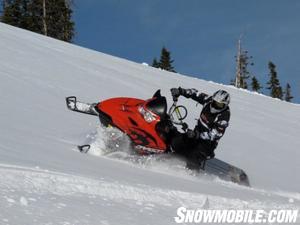 The Dragon 800 has excellent roll-from-center which makes it a capable boondocker.
The Dragon 800 has excellent roll-from-center which makes it a capable boondocker.
The Dragon feels mountain man. When we swing a leg over the seat and yo-yo the pull rope from its cage, giving fire to the twin, the Dragon testifies of its own capabilities. Like the Team’s 700 RMK, we can’t get enough of this mountain sled.
The Dragon’s Liberty 800 Cleanfire (fuel) Injected (CFI) twin-cylinder two-stroke motor is powerful and responsive to changing elevations. Its 155 horsepower doesn’t feel as snappy as the 700, but its big lungs pull long hills with ease. It’s displacement and torque overcomes the 700’s snappy feel.
In mid-January we began to notice at the 6000 to 6600 RPM range, the CFI 800 began to drop power and track speed. Also, the speedo head was flashing a red light when snow loads became heavy. Heeding these warnings signs, we sent the Dragon to Rexburg Motor Sports, Rexburg, Idaho, for a reflash and updates to the CFI fuel map. That five-minute computer update given by the service department eliminated the lean spots in the 6000 range.
At this point, we give praise to the Dragon’s suspension and its Walker Evans shocks. Like, “Wow!” To that end, we appreciate the sled’s willingness to roll into a hill for smart and simple sidehilling. It is oh-so proficient at this. The Dragon, despite being our heaviest two-stroke 800 mountain sled, is the lightest through the bars.
Lastly, the Pro-Taper bars and handlebar height, coupled with the Dragon’s smartly sculptured seat are, well, perfect. Really.
Kevin’s Ride Impressions
Polaris’ 800 Dragon, is, in my opinion, the easiest mountain sled to ride when it comes to sidehilling in deep or hard pack snow. The Dragon requires very little effort to rip a sidehill, and when zipping down the trail, the Dragon is very comfortable and predictable — give credit to its Walker Evans shocks. The 800 twin two-stroke starts easy and runs great. The Dragon’s 2.4-inch paddle track works great in the deep snow. However, in the harder snow, it seems to struggle to hook up. At the cockpit, the Pro Taper handlebars fit nicely in my hands. The overall fit and finish, and feel of our 800 Dragon is excellent.
And now, Polaris’ 700 RMK. In a few words, the 700 RMK is the biggest bang for your buck. We’re impressed with the 700 RMK’s performance. It truly thinks it’s an 800, though “700” is emblazoned on its hood. The 155-inch track with 2.4-inch paddles is the perfect match for this sled. Like the Dragon, the mountain-specific handling the 700 RMK delivers is right where it needs to be, positive, easy, and obedient.
Arctic Cat M1000— The ultimate ride
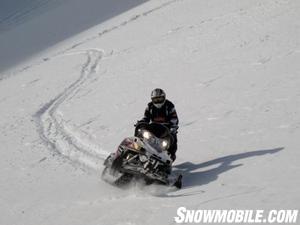 The M1000 Sno Pro remains an all time fave as its torque and power are powder killers.
The M1000 Sno Pro remains an all time fave as its torque and power are powder killers.
One must really be a poor rider, somewhat stupid, to bury the M1000. Our 163-inch Sno Pro makes simple work out of a steep hill that is infested with waist-deep powder. In fact, we learned on one outing that we had to work at blowing out the track and becoming stuck. The motor’s torque, coupled to the industry’s best powder track, the Power Claw, creates an ultimate ride.
The big 1000 twin shakes the hood and handlebars like a top-fuel alcohol dragster when idling. But when the shakes are quieted from throttle pinching, a sweet calm fills the air as torque and power come to life. This is a true muscle sled. However, the big “Thou” still has exhaust dump problems. When stuffing the right side into a horrible sidehill run in deep powder, the pipe plugs and chokes life from the motor. Oh, it is not as bad as previous years, but still present.
So far, we have logged 300 miles on the Big M with no worries or concerns. It holds its RPM where designed and never falters when pushed.
The motor is heavier than the 800 twin housed in the M8, and though the two engines share approximately the same horsepower, the M1000’s torque is wonderful. Don’t forget, we are knocking out a duel between the M1000 and M8 – torque vs. horsepower vs. weight. Stay tuned.
The Arctic front suspension makes rolling the big M from left to right and back, easy. With its telescoping handlebars, well-designed seat and runningboards, the M1000 fits our team of drivers with nary a worry.
Arctic Cat M8 Sno Pro 163— The nastiest 800 going
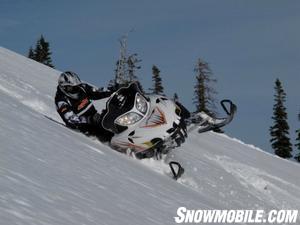 Cat’s M8 is a showcase of power, finesse and nimbleness. It is the standard for 2010.
Cat’s M8 is a showcase of power, finesse and nimbleness. It is the standard for 2010.
The Snowmobile.com M8 showed up in our riding stable right around New Year’s and, thus, has the fewest miles on it.
It did not take us long to realize that Cat made the right choice by throwing its new High Output 800 twin into its M chassis. Nothing touches it, except for the M1000. The light Sno Pro chassis sled is overly simple to drive and maneuver in the deep powder and in the trees.
In our Powder Sled Evaluation, we are going to match the M8 against our 800 Dragon for head-to-head knocking. These two sleds are evenly matched, from handlebar rotation, to horsepower and to roll characteristics. That will make for good riding and some fun writing.
Anyway, our M8 has proved to be a rider-compliant sled. However, we have noticed when ridden to heights beyond its clutch settings, the “R’s” readily drop out of its optimum zone by 500 (which is expected). When this happens, the motor runs flat. Unlike the M1000, which has a greater torque band to muscle through thin air when out of its clutch settings for a given altitude range, the M8 does not have that safety net when pushed beyond its calibration for a given altitude range. For our Powder Sled Evaluation, we will hold the sled to the 6,000 foot to 8,000 foot range.
The 2009 M8 introduced a lighter tunnel, lighter front and rear suspension, reduced rotating mass, light race seat, electronic reverse, and telescoping handlebars. These changes dropped 22-pounds from the M8.
The 2010 M8 has the ’09 enhancements, but comes with an all-new motor and is no longer the under-powered 800. From our impressions, the M8 has become the nastiest 800 on the snow. Our Powder Sled Evaluation will prove or disprove this theory.
Kevin’s Ride Impressions
Arctic Cat’s M1000 remains a powerhouse. Period. Most riders don’t appreciate its power and torque until the big twin mill delivers its big hit power in the deep-and-steep; this is where the one-liter twin really shines. Additionally, the Power Claw track is at its best when controlled by the M1000’s voracious torque. The M1000 is an impressive climber, especially in this year’s soft snow.
For both the M1000 and M8 Sno Pros, I’ve noticed improved heat dissipation around the oil and coolant bottles. Cat’s use of Frog Skinz was a good decision that works well at holding out snow from under the hood. For the 2010 M Sno Pro series, all received a new high-profile lightweight seat with water proof storage. This is greatly appreciated.
For the M8, its 800cc motor is for real — all 165 horsepower! In the backcountry and in competitive hillclimbs, it is the sled and motor combination to beat. It hits hard and keeps going. As for backcountry tree running and knocking through the nasty stuff, the Arctic M series is a favorite to use if you want to grab a mountain and shake it up.
Related Reading
2010 Arctic Cat M1000 Sno Pro 162 Review
2010 Arctic Cat M8 Review
2010 Yamaha FX Nytro MTX SE 162 Review
2010 Polaris 700 & 600 RMK Review
2010 Polaris 700 & 600 RMK Review
All Mountain Reviews on Snowmobile.com



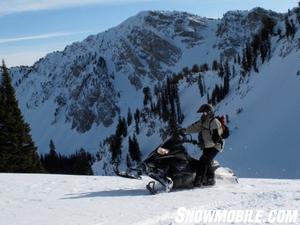


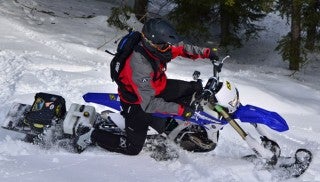


 Your Privacy Choices
Your Privacy Choices